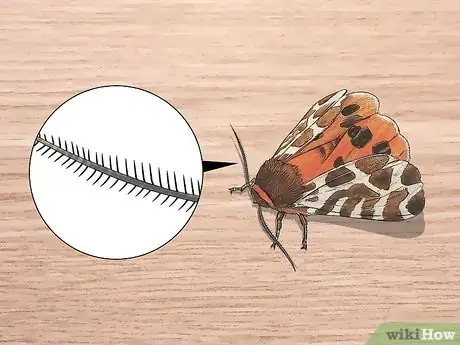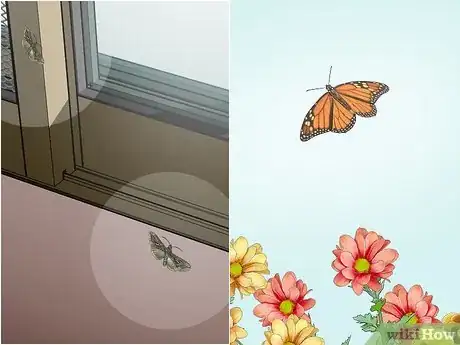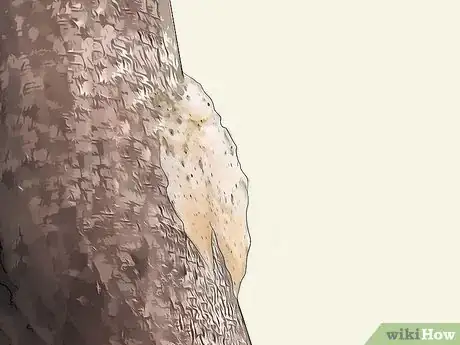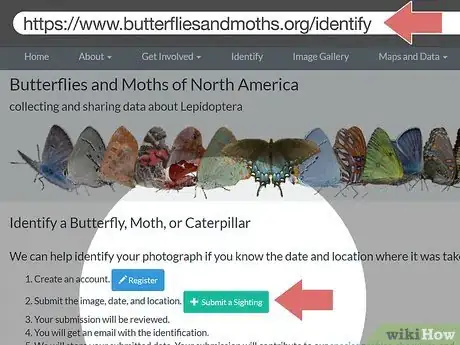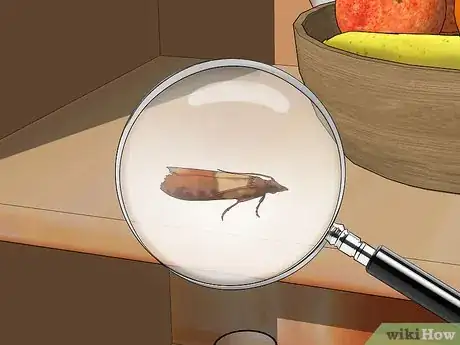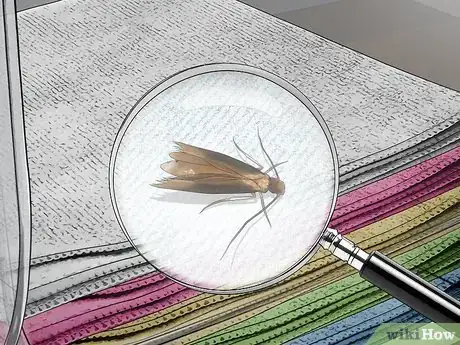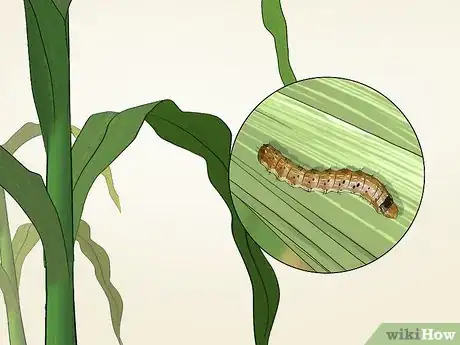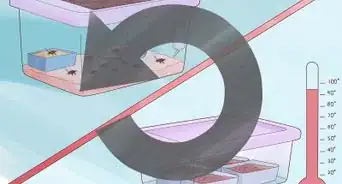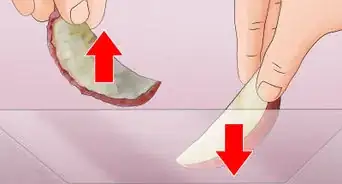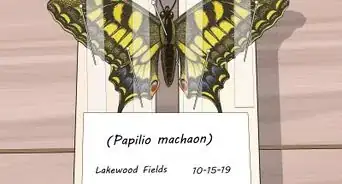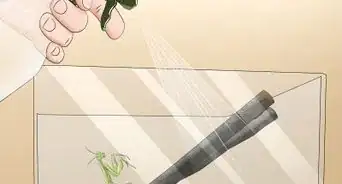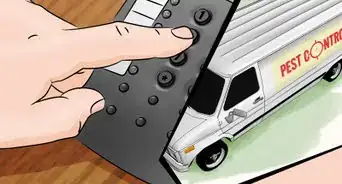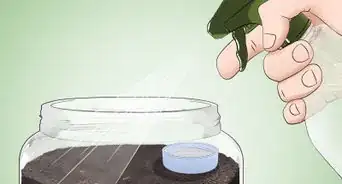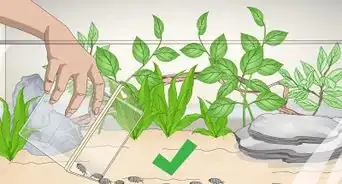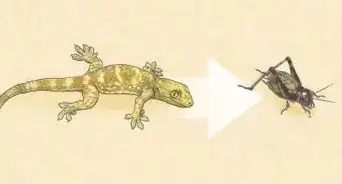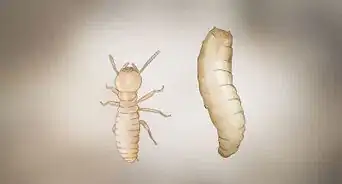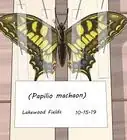This article was co-authored by Shweta Sharma. Shweta Sharma is a Biologist with the U.S. Environmental Protection Agency (EPA). With nearly ten years of experience, she specializes in insect management, integrated pest management, insect behavior, resistance management, ecology, and biological control. She earned her PhD in Urban Entomology and her MS in Environmental Horticulture from the University of Florida. She also holds a BS in Agriculture from the Institute of Agriculture and Animal Sciences, Nepal.
There are 14 references cited in this article, which can be found at the bottom of the page.
This article has been viewed 15,580 times.
If you've found a small winged creature you want to identify, you just need to use a few tips and a couple of solid resources to help you figure it out. While moths are members of the Lepidoptera order just like butterflies, you'll find some key differences between the two if you're looking closely. You can also use databases to identify specific moths. If you're having problems with pest moths in your home or garden, take the time to identify them so you can figure out the best way to get rid of them.
Steps
Telling the Difference between a Moth and Butterfly
-
1Check for feathery antennae to spot a moth. Moths' antennae are saw-edged or feathery. On the other hand, a butterfly's antennae tend to be club-shaped. They consist of long tubes with a small bulb on the end.[1]
- The antennae of both moths and butterflies vary in length and width.
-
2Look for moths at night. Moths tend to be nocturnal, meaning they are usually out at night. Butterflies, on the other hand, are typically diurnal, meaning they are usually out during the day.[2]
- For instance, you may see moths fluttering around your porch light at night.
- There are a few exceptions to this rule. For instance, the Buck Moth flies during the day.[3]
Advertisement -
3Pay attention to how moths flatten their wings when they land. Butterflies tend to hold their wings upright when they land, perpendicular or at an angle to the ground. Moths, on the other hand, tend to hold them down against their bodies, parallel to the ground.[4]
-
4Notice the muted colors and smaller size of moths. Moths are typically smaller overall than butterflies. Similarly, their colors aren't as bright as butterflies, who tend to have very bright colors.[5] However, there are exceptions to this rule, such as the Madagascan sunset moth, which is brightly colored.[6]
- The wing colors of moths and butterflies serve several purposes. The colors help them identify the right mate, and the wings of certain brightly colored butterflies, such as Monarch Butterflies, tell predators that they aren't tasty.
- Plus, the colors of both moths and butterflies can help them camouflage themselves with their surroundings.[7]
-
5Look for a short and fuzzy body to identify moths. The bodies of butterflies tend to be long and slender with smooth, sleek bodies. Moths have shorter, wider bodies with a soft, fur-like coating.[8]
-
6Watch for a silky covering when a moth is in its cocoon. Both moths and butterflies go through a pupa stage where they cover themselves up while they are developing. However, moths' cocoons have a silky covering, while butterflies' chrysalises do not.[9]
- Also, chrysalises are hard while cocoons are not.
Pinpointing a Specific Local Moth
-
1Submit a photograph to a database. Some databases allow you to upload photos of butterflies or moths, once you create an account with them. Then, the experts on the site or the online community will help you identify your moth.[10]
- For instance, try https://www.butterfliesandmoths.org/identify.
- It helps to have the time, date, and location where you took the picture, as some species can be identified by migration patterns.
- You can also upload a picture of a caterpillar.
-
2Browse a photo gallery of moth species in your area. Many universities, scientific organizations, and regional park websites list moths that are specific to your area. You can browse the site until you find a moth that matches the one you're trying to identify.[11]
- Try to find a database that's as narrow as possible. For instance, instead of searching for "Oklahoma moth database," try looking for "Wichita Mountain moth database," which narrows it to an area in Oklahoma.[12]
-
3Search a large database by adding filters. Some larger databases will let you narrow your search by certain characteristics. For instance, you can put in the size, color, country, and markings to make it easier to find your moth.
- When picking a color, choose the most obvious one on the moth.
Distinguishing Common Household and Garden Pest Moths
-
1Look for small, brownish moths in your pantry area. Pantry moths are also known as Indian Meal Moths. They are tiny, about a 1⁄2 inch (1.3 cm) in length, and very good at hiding, but you may also spot webbing in your pantry, as well as holes in packages. If you suspect a package has moths, look inside to see if it has any strange clumping or bad odors, which can indicate larvae. Toss it if you suspect you have moths.[13]
- These moths often come into your house from the grocery store, in goods like cereal, flour, rice, chocolate, beans, pasta, and powdered milk. You can prevent infestations by storing these foods in your freezer for 4 days when you bring them home, which kills the moths.
- Pet food and birdseed can also carry infestations, so store them away from your pantry.
- To rid yourself of these moths, clean out the pantry, and throw any suspicious containers into an outside trash bin. Vacuum inside the pantry, and then scrub it down thoroughly with soap, water, and a scrubbing sponge. Call an exterminator to set traps.
-
2Check for clothes moths in your closets. The larvae of clothes moths tend to feed on natural fabrics like wool and fur. They typically won't eat cotton or synthetic fabrics unless they haven't been washed; the larvae enjoy the body oils and skin cells left on the fabric.[14]
- These moths are tiny, about 1⁄4 inch (0.64 cm) in length. They hang out in the dark areas of your closet, and they will scurry away when startled. They tend to run or jump more than fly, but they do have a fluttery flight pattern.
- The two most common clothing moths are the Webbing Clothing Moth, which is golden/tan with reddish-gold hair on its head, and the Casemaking Moth, which is lightly brown with lighter hair on it head. The Casemaking Moth can also have dark spots.[15]
- Look for furrows or holes in your clothing, particularly wool clothing.
- To rid your clothes of the moths, wash any clothing in hot water and dry in low heat. You can also freeze the clothing for 24 hours. Large rugs that are infested with moths will need to be treated by a professional, though vacuuming may help.[16]
-
3Watch for 4 in (10 cm) light green caterpillars on tomatoes. These caterpillars, known as Hornworms, have a horn on their head, white diagonal stripes, a large black ring under each stripe, and black spots along their bodies. The adult moths are 4 to 5 inches (10 to 13 cm). They're gray with orange spots.[17]
- These caterpillars wreak havoc on nightshade plants, which include tomatoes, eggplant, peppers, and potatoes. They eat the leaves and green fruit, and leave bacteria on the plants through their feces.
- Prevent these moths by using floating row covers, which are clear plastic covers that go over the plant. You stake them into the ground on both sides. You can also pick off the caterpillars by hand and drown them in a bucket of water with a bit of dish soap.
-
4Check for 2 in (5.1 cm) light green or black caterpillars on corn. These caterpillars are known as Corn Earworms, and they can also be brownish or pink. They usually have stripes going from head to tail and warts sprouting tiny spines. The adult moths are tan or yellowish and reach 1.5 to 2 inches (3.8 to 5.1 cm).[18]
- Corn Earworms enjoy corn, beans, squash, sunflowers, tomatoes, and peppers. They will eat the leaves of these plants, as well as the kernels and tassels of corn. They'll eat deep in tomatoes, as well.
- You can also use floating covers to keep out these moths or handpick the caterpillars off.
- Put a drop of mineral oil on each ear of corn as it appears and wrap the tip with a rubber band, both of which will deter the caterpillars.
-
5Notice 1.5 in (3.8 cm) green caterpillars with a yellow stripe. These caterpillars, also known as Cabbage Worms, grow into white moths with black markings. They munch on anything in the cole family, including cabbage, Brussels sprouts, broccoli, kale, and cauliflower. They will eat the leaves and chew into the cabbage heads.[19]
- Use floating covers to keep the moths off your plants. Remove caterpillars individually.
Expert Interview

Thanks for reading our article! If you'd like to learn more about moths, check out our in-depth interview with Shweta Sharma.
References
- ↑ https://www.loc.gov/rr/scitech/mysteries/butterflymoth.html
- ↑ https://www.livescience.com/34472-difference-between-moth-butterfly.html
- ↑ https://www.loc.gov/rr/scitech/mysteries/butterflymoth.html
- ↑ https://www.livescience.com/34472-difference-between-moth-butterfly.html
- ↑ https://www.loc.gov/rr/scitech/mysteries/butterflymoth.html
- ↑ https://www.livescience.com/34472-difference-between-moth-butterfly.html
- ↑ https://www.kidsbutterfly.org/faq-page/why-do-some-wings-have-such-brilliant-colors-why-are-some-so-dull
- ↑ https://www.livescience.com/34472-difference-between-moth-butterfly.html
- ↑ https://www.loc.gov/rr/scitech/mysteries/butterflymoth.html
- ↑ https://www.butterfliesandmoths.org/identify
- ↑ https://www.ndsu.edu/ndmoths/ndmoths/photo_gallery.htm
- ↑ https://www.fws.gov/uploadedFiles/Region_2/NWRS/Zone_1/Wichita_Mountains/Sections/Cosa/WildlifeHabitat/04%20Common%20Butterflies,%20Moths%20AChiri%20508.pdf
- ↑ https://www.networx.com/article/identifying-and-preventing-pantry-moths
- ↑ http://ento.psu.edu/extension/factsheets/clothes-moth
- ↑ http://ipm.ucanr.edu/PMG/PESTNOTES/pn7435.html
- ↑ http://ento.psu.edu/extension/factsheets/clothes-moth
- ↑ http://www.oregonlive.com/hg/index.ssf/2013/09/good_bugs_in_the_garden_--_and.html
- ↑ http://www.oregonlive.com/hg/index.ssf/2013/09/good_bugs_in_the_garden_--_and.html
- ↑ http://www.oregonlive.com/hg/index.ssf/2013/09/good_bugs_in_the_garden_--_and.html
